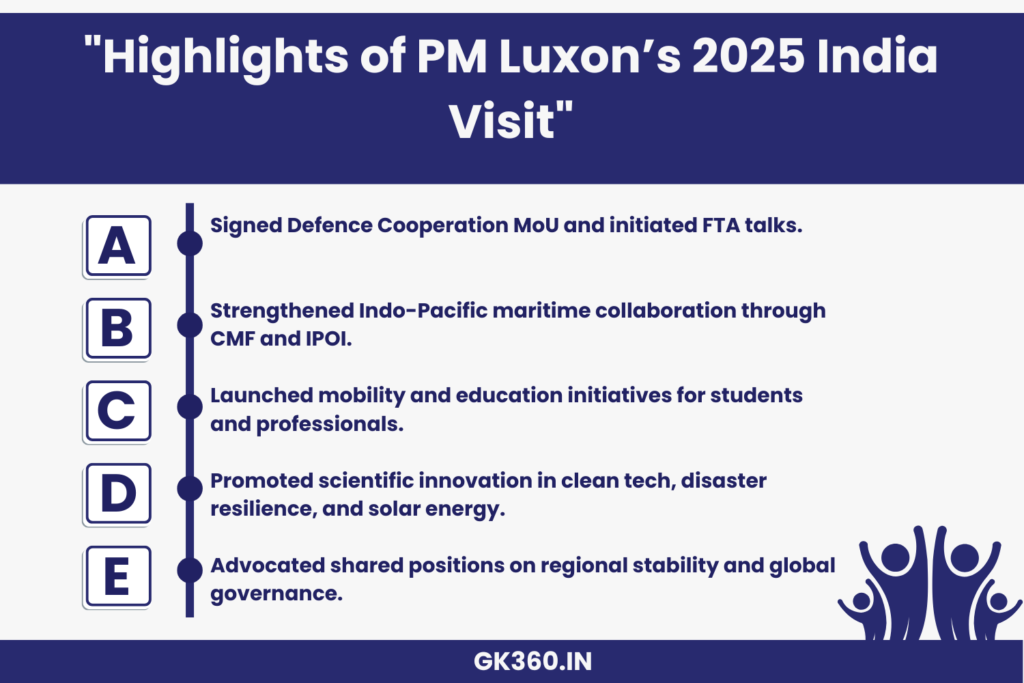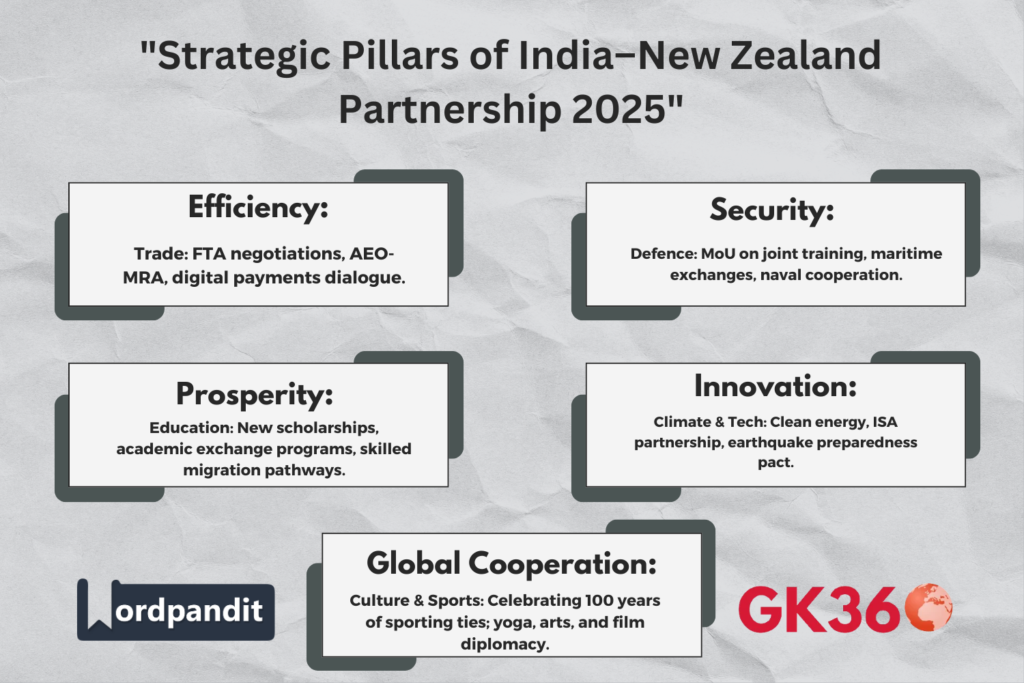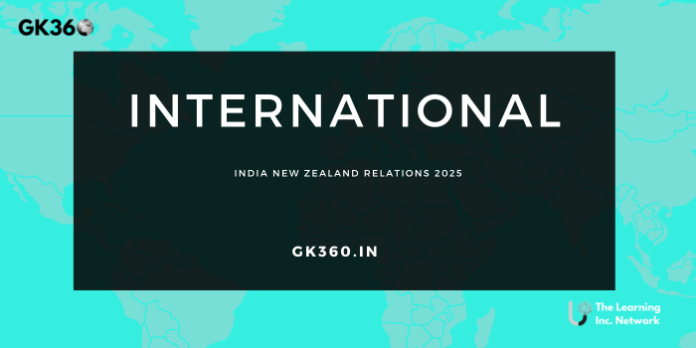India New Zealand Relations 2025: Key Outcomes of PM Christopher Luxon’s Landmark Visit
Strengthening Strategic Ties in the Indo-Pacific
Prime Minister Christopher Luxon’s official visit to India (March 16–20, 2025) marked a transformative moment in India–New Zealand bilateral relations. This high-level engagement laid the foundation for a more comprehensive partnership in trade, defence, education, and the Indo-Pacific strategy. As the Chief Guest of the Raisina Dialogue 2025, Luxon’s presence reinforced New Zealand’s commitment to a rules-based order and regional cooperation.

Table of Contents
- India–New Zealand Diplomatic Engagements
- Trade and Economic Cooperation
- Defence and Indo-Pacific Strategy
- Science, Technology, and Climate Resilience
- Education, Mobility, and Cultural Diplomacy
- Regional Stability and Multilateral Cooperation
- FAQs
- Conclusion
India–New Zealand Diplomatic Engagements
Prime Minister Christopher Luxon received a ceremonial welcome in New Delhi, highlighting the warmth of India–New Zealand diplomatic ties. He paid homage to Mahatma Gandhi at Raj Ghat, symbolizing shared democratic values.
A central highlight was his bilateral meeting with Prime Minister Narendra Modi, where both leaders reaffirmed their intent to strengthen cooperation across strategic sectors. In a powerful symbolic moment, PM Luxon delivered the Inaugural Keynote Address at the Raisina Dialogue 2025, emphasizing New Zealand’s increasing engagement in Indo-Pacific affairs.
Discussions focused on:
- Enhancing regional peace and security.
- Promoting a rules-based Indo-Pacific order.
- Broadening cooperation in multilateral forums.
Trade and Economic Cooperation
India and New Zealand agreed to bolster trade by launching negotiations for a Free Trade Agreement (FTA)—a milestone aimed at unlocking deeper economic integration.
Key economic developments included:
- Initiation of digital payments dialogue, reflecting the global fintech shift.
- Signing of the Authorized Economic Operators Mutual Recognition Arrangement (AEO-MRA) to streamline customs and enhance bilateral trade facilitation.
- Agreements in horticulture and forestry sectors to promote sustainable agricultural cooperation.
Tourism and aviation also received a boost with updates to the Air Services Agreement and plans to launch direct flights, further strengthening people-to-people connectivity.
Defence and Indo-Pacific Strategy
A major leap in bilateral security cooperation came with the signing of a Defence Cooperation MoU. This agreement aims to:
- Enable joint training exercises and officer exchanges.
- Facilitate mutual naval visits to strengthen maritime engagement.
New Zealand expressed strong support for:
- India’s growing role in regional security frameworks like the Combined Maritime Forces (CMF).
- India’s Indo-Pacific Oceans Initiative (IPOI), particularly in maritime safety and sustainability.
In a unique cultural-strategic crossover, the two nations also discussed India’s National Maritime Heritage Complex (NMHC) in Gujarat, linking diplomacy with shared maritime history.
Science, Technology, and Climate Resilience
India and New Zealand reaffirmed their commitment to scientific innovation and sustainable development through enhanced collaboration in:
- Clean technology and climate action
- Joint innovation programs in science and research
- Earthquake risk management and disaster resilience
New Zealand formally joined the Coalition for Disaster Resilient Infrastructure (CDRI), strengthening cooperation on resilient urban planning. The country also endorsed India’s leadership in the International Solar Alliance (ISA), paving the way for joint efforts in solar energy access and innovation.
A forthcoming Memorandum of Cooperation on Earthquake Preparedness is also expected to deepen knowledge-sharing and emergency response coordination.
Education, Mobility, and Cultural Diplomacy
Education featured as a high-priority area, with both sides signing a refreshed Education Cooperation Arrangement aimed at:
- Facilitating student mobility and scholarships
- Boosting academic exchange programs and research
- Supporting Indian students pursuing higher education in New Zealand
Discussions also focused on mobility frameworks for skilled professionals, signaling progress toward future migration and workforce agreements.
In the cultural realm, the signing of a Memorandum of Cooperation on Sports celebrated 100 years of sporting ties, with a vision to enhance sports exchanges, especially in cricket and rugby.
To promote soft diplomacy, the two countries agreed to support:
- Yoga and Ayurveda promotion
- Bilateral art and music festivals
- Film collaborations and cultural exhibitions
Regional Stability and Multilateral Cooperation
Both leaders emphasized their commitment to maintaining an open, inclusive, and rules-based Indo-Pacific.
Key shared positions included:
- Strong support for freedom of navigation and maritime security.
- Reaffirmation of international law, particularly the UN Convention on the Law of the Sea (UNCLOS).
- Joint condemnation of terrorism and commitment to combating terror financing networks.
New Zealand reaffirmed its backing for India’s bid for permanent membership in the UN Security Council, reflecting alignment on global governance reform.
The two sides also jointly advocated for:
- A negotiated two-state solution to the Israel-Palestine conflict
- Peaceful resolution in Ukraine, through diplomacy and international cooperation

FAQs
- What was the purpose of New Zealand PM Christopher Luxon’s 2025 visit to India?
The visit aimed to strengthen bilateral ties in areas such as trade, defence, education, climate action, and Indo-Pacific strategy. - What agreements were signed during the visit?
Key agreements included an MoU on Defence Cooperation, updated Air Services Agreement, education arrangements, AEO-MRA for customs, and new cultural/sports diplomacy pacts. - What is the significance of New Zealand joining the CDRI?
It enhances collaboration with India on disaster-resilient infrastructure and aligns both countries on climate resilience priorities. - How are India and New Zealand cooperating in the Indo-Pacific?
They are coordinating on maritime security, supporting rules-based order, and engaging in multilateral initiatives like the Indo-Pacific Oceans Initiative and CMF. - How will the visit benefit students and professionals?
New education agreements and mobility dialogues will open up more opportunities for Indian students and skilled professionals in New Zealand.
Conclusion
Prime Minister Christopher Luxon’s India visit in March 2025 marks a new chapter in the India–New Zealand comprehensive strategic partnership. The outcomes—from launching FTA talks and deepening defence ties to cultural diplomacy and Indo-Pacific engagement—signal a shared vision for peace, prosperity, and resilience.
As both nations navigate an evolving global order, this visit has not only reaffirmed their diplomatic alignment but also laid the foundation for future cooperation across geostrategic, economic, and human-centric domains.
Key Takeaways Table
| Aspect | Details |
| Diplomatic Engagement | PM Luxon received a ceremonial welcome, paid tribute at Raj Ghat, and was Chief Guest at Raisina Dialogue 2025. |
| Trade and Economy | FTA talks launched; AEO-MRA signed; progress in digital payments, forestry, horticulture, aviation, and tourism. |
| Defence & Indo-Pacific Strategy | MoU on defence; naval visits; support for IPOI and CMF; focus on maritime heritage and sustainability. |
| Science & Climate Resilience | Cooperation on clean tech, ISA, CDRI, earthquake preparedness; focus on sustainable infrastructure. |
| Education & Mobility | Refreshed education pact; student scholarships; mobility frameworks for skilled professionals. |
| Cultural & Sports Diplomacy | Celebrated 100 years of sports ties; collaboration in yoga, film, music, and bilateral cultural festivals. |
| Multilateral Cooperation | Support for UNSC reform; joint stance on UNCLOS, counter-terrorism, Israel-Palestine and Ukraine issues. |





